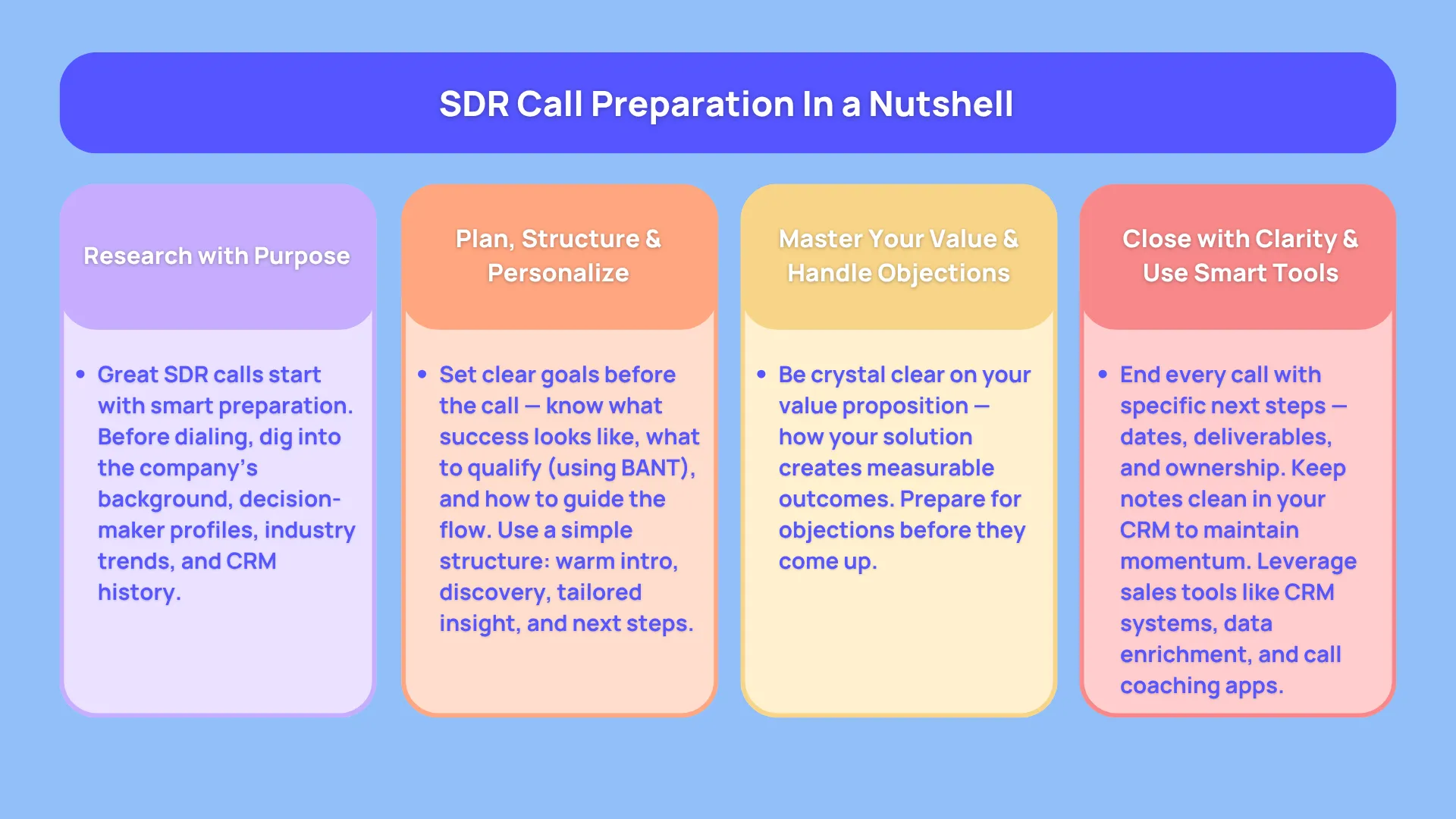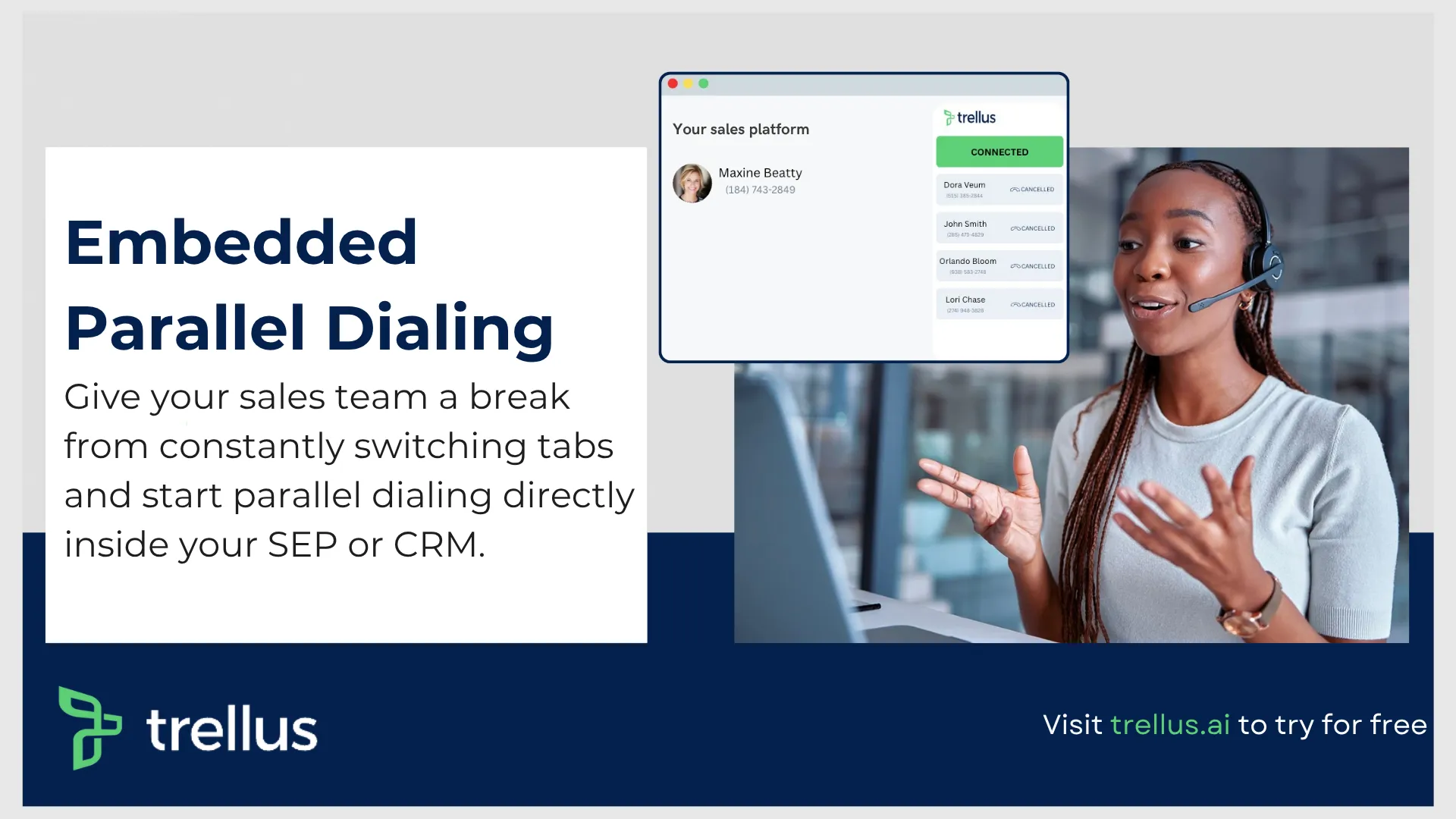
Our Top Picks


Salespeople often get labeled as “pushy” or “spammy,” and honestly, it’s not hard to see why. The average prospect’s inbox is flooded with generic pitches, half-hearted follow-ups, and irrelevant offers. Research shows that only about 24% of outreach emails even get opened, and that’s before we count the number of calls that go unanswered.
The real problem isn’t the act of reaching out; it’s the lack of preparation. Too many reps focus on how many dials they can make instead of how much insight they can bring to a single conversation. That’s the difference between sounding like a telemarketer and coming across as a trusted advisor.
Great sales call preparation isn’t about memorizing a script. It’s about understanding your prospect’s world so well that your call feels natural, relevant, and genuinely helpful.
Below is a full framework to help you prepare for every sales conversation, from the first discovery call to your later-stage demos, so you can show up confident, credible, and ready to create real value.

1. Do Your Research
Every successful sales call begins long before you pick up the phone. A solid pre-call research checklist helps you gather the context you need to steer the conversation intelligently.
Here’s what to look for before the meeting:
- Company background: Check their website’s “About” and “News” sections to learn how they position themselves and what recent initiatives or changes they’ve announced.
- Decision-maker insights: Review your contact’s LinkedIn profile. See what kind of content they engage with, how long they’ve been in their role, and what their professional priorities might be.
- Industry context: Follow their company on social channels like Twitter or X. Observe any market trends or competitive shifts that may be influencing their buying decisions.
- CRM records: Study your internal CRM notes organization to review previous interactions, emails, or deal notes. Identify what’s already been discussed and what hasn’t been resolved.
The more context you have, the easier it is to tailor your questions. You’ll also come across as someone who respects their time , which instantly builds credibility.
2. Define Clear Goals Before the Call
Every successful rep knows what they want to achieve before the conversation even starts. Think beyond just “setting a meeting” or “pitching the product.”
Ask yourself:
- What information do I need to qualify this lead?
- What would success look like by the end of this call?
- What specific pain points should I help uncover or clarify?
This step ties directly into qualifying leads before a sales call. If you’re running a discovery conversation, use BANT qualification questions (Budget, Authority, Need, Timeline) to figure out if the prospect truly fits your ideal profile.
You might not hit every letter of BANT on one call, but having those dimensions in mind helps you direct the conversation naturally. Instead of guessing, you’re listening with purpose.
Once you’ve set your call goals, note them down in your meeting preparation template , even a simple checklist in your CRM or a notebook works. Clarity before the call translates into confidence during it.
3. Structure the Conversation
A sales call can easily go off track if you don’t have a loose framework guiding it. Think of it as your personal sales call planning steps.
Here’s a basic structure that works for most reps:
- Warm Introduction: Briefly thank them for their time, state the purpose of your call, and set expectations on timing.
- Discovery and Context: Ask open-ended questions to uncover their challenges and objectives.
- Tailored Insights: Share relevant examples or stories that connect your solution to their goals.
- Next Steps: Summarize key takeaways and propose specific follow-up actions.
Mapping out the flow ahead of time gives you more control. It prevents awkward silences, ensures you cover essential ground, and helps you build rapport from the very first contact.
When you sound organized but conversational, prospects trust you faster. It shows that you’ve put thought into their time, not just your quota.
4. Customize Your Presentation
No two prospects are alike, which means no two calls should sound alike either. Personalized conversations are the backbone of effective selling.
Your goal during discovery call preparation is to craft your message in a way that fits their world. Reference insights from your research , company size, growth stage, or challenges they’ve recently mentioned.
This is also where presentation storytelling for sales becomes a superpower. Instead of listing features, wrap your solution in relatable stories:
- “I was speaking with another logistics manager last week who had the same issue with supplier coordination…”
- “One of our clients in fintech went through something similar, and here’s how they turned it around...”
Stories like these anchor your product in reality. They give prospects something to picture instead of a wall of jargon.
The best storytellers don’t make the story about the product , they make it about the prospect’s transformation.
5. Know Your Value
You have just a few minutes to prove that your conversation is worth their time. That’s why understanding your value proposition is crucial before the call begins.
Ask yourself:
- What measurable outcomes can your solution create for this specific buyer?
- How does it make their life easier, faster, or more efficient?
- What’s one stat or proof point that reinforces your credibility?
Make sure you’re ready to articulate that clearly and confidently. A rushed or vague answer can instantly kill momentum.
When you know your value inside and out, you stop sounding like a salesperson and start sounding like a consultant.
6. Prepare for Potential Objections
Every rep, no matter how seasoned, encounters pushback. The difference between losing momentum and earning respect is how well you prepare for it. Objections aren’t rejections , they’re signals that your prospect is thinking critically about the decision.
Start by predicting the most likely hesitations you’ll face. Consider their company size, budget, current vendor relationships, or the stage of their buying process. Use what you know from your CRM records to anticipate their mindset.
You might hear things like:
- “We already have a similar system in place.”
- “This isn’t a priority right now.”
- “Your price seems higher than what we’re paying.”
Prepare concise, empathetic responses that acknowledge the concern and reframe it in terms of value. If someone mentions cost, connect your solution back to measurable outcomes , saving time, reducing churn, or cutting operational overhead.
Keep your notes organized in your CRM or a dedicated objection-handling document. Having quick access to these points during your call helps you stay composed and confident.
When you treat objections as part of the conversation rather than interruptions, you instantly position yourself as a trusted professional instead of a pushy seller.
7. Visualize Success
Confidence isn’t something you can fake for long , it comes from preparation and mental rehearsal. Great sales reps treat calls like athletes treat a big game. They warm up mentally, clear distractions, and picture the conversation unfolding smoothly.
Before each call, take a few minutes to visualize:
- The tone you want to set in the first thirty seconds.
- How you’ll handle moments of silence or hesitation.
- The exact words you’ll use to ask for next steps.
If you struggle with nerves, talk through your opening line aloud. It sounds simple, but hearing your own voice removes tension and helps you sound natural once the call begins. Some reps also use call coaching apps that record and replay practice runs, so they can improve tone, pacing, and delivery.
This small mental exercise sharpens your focus and ensures that when it’s go-time, your confidence sounds effortless.
8. Finish with Specifics
One of the biggest mistakes reps make is ending a great call without clear next steps. You’ve built rapport, shared insights, maybe even impressed them , but if you don’t agree on what happens next, the energy fades quickly.
Aim to wrap up every conversation with specifics. Summarize what you discussed and confirm next actions with dates and ownership. You could say:
- “I’ll send over the proposal and case study by Thursday.”
- “Let’s schedule a quick follow-up next Tuesday to review feedback.”
A simple, organized recap shows you respect their time and keeps both sides aligned.
You can use meeting preparation templates within your CRM to track these action items. Many CRM systems allow you to set reminders and follow-up tasks linked directly to call notes. These CRM notes organization tips prevent opportunities from slipping through the cracks and help you maintain consistent communication.
Ending with clarity turns a single conversation into a reliable part of your pipeline , and that’s where deals start to build momentum.
9. Speak Carefully About Competitors
It’s easy to get defensive when your prospect mentions a competing vendor. You’ve spent time perfecting your product pitch, so it’s tempting to point out every flaw in the other solution. But that rarely earns trust.
Instead, take a calm, professional approach. Acknowledge what the competitor does well and then shift focus to what makes your solution unique.
For instance, you might say, “They’re a solid option for companies focused purely on automation. Where our clients tend to see the difference is in flexibility and support during scale-up.”
This kind of phrasing positions you as objective and confident, not combative. It also opens the door for deeper questions: what exactly does the prospect value most , cost, scalability, service, or innovation?
Understanding that nuance helps you refine your pitch later in the sales cycle. Competitor comparisons shouldn’t sound like a battle; they should sound like intelligent market conversations that underline your product’s place in the ecosystem.
10. Use the Right Tools

Preparation doesn’t just happen on paper , it lives in the systems and apps you use every day. The best reps know that modern sales success depends on the right mix of tools that reduce busywork and sharpen focus.
Here are some essentials to keep in your workflow:
- CRM platforms: Centralize customer data, track interactions, and apply CRM notes organization tips for cleaner follow-ups. A well-maintained CRM means you always know where each prospect stands in the pipeline.
- Call coaching apps: Record, analyze, and score your conversations to pinpoint where you lose momentum or miss cues. Reviewing real calls is one of the fastest ways to improve.
- Meeting preparation templates: Many sales enablement tools include customizable templates to help you outline call objectives, talking points, and follow-up plans.
- Data enrichment tools: Pull updated company and contact insights directly into your CRM so your pre-call research is always fresh and relevant.
Technology should make you more human, not robotic. When used well, these tools give you the freedom to focus on building authentic connections instead of chasing admin work.
Bringing It All Together
Mastering sales call preparation is what separates order-takers from trusted consultants. Every touchpoint , from your pre-call research checklist to your discovery call preparation guide , shapes how the buyer experiences you.
When you prepare deeply, you don’t just sound confident; you sound curious, relevant, and genuinely invested in solving their problem. You qualify smarter, tell better stories, and guide the conversation toward meaningful next steps.
The best salespeople aren’t the ones who talk the most , they’re the ones who listen the best because they’ve done their homework.






